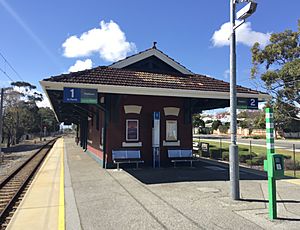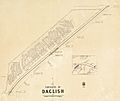Daglish, Western Australia facts for kids
Quick facts for kids DaglishPerth, Western Australia |
|||||||||||||||
|---|---|---|---|---|---|---|---|---|---|---|---|---|---|---|---|

Stubbs Terrace
|
|||||||||||||||
| Population | 1,419 (2016 census) | ||||||||||||||
| Postcode(s) | 6008 | ||||||||||||||
| Location | 5 km (3 mi) W of Perth CBD | ||||||||||||||
| LGA(s) | City of Subiaco | ||||||||||||||
| State electorate(s) | Nedlands | ||||||||||||||
| Federal Division(s) | Curtin | ||||||||||||||
|
|||||||||||||||
Daglish is a small western suburb of Perth, the capital of Western Australia. It is approximately 4 kilometres (2.5 mi) west of the Perth central business district, and within the City of Subiaco local government area. It was named after Henry Daglish, who was the Mayor of Subiaco, member for the electoral district of Subiaco and Premier of Western Australia from 1904 to 1905. The Daglish railway station opened in 1924 in response to population growth in the neighbouring suburb of Subiaco. The following year, the Municipality of Subiaco bought the land west of the railway station to sell for housing. Development occurred over the following 20 years. The initial development next to the railway station used the garden suburb principles, with large lots and gardens, curved streets, and lots of green space. Today, the suburb has significant heritage value due to its uniform streetscape, with most original homes still standing. It has a population of 1,419 as of the 2016 Australian census.
Contents
Demographics
Daglish's population at the 2016 Australian census was 1,419. This is a decrease from the 1,494 recorded at the 2011 Australian census, and an increase from the 1,242 recorded at the 2006 Australian census and the 1,215 recorded at the 2001 Australian census. 49.3% of residents were male, and 50.7% were female. The median age was 39 years, above the state's average of 36.
At the 2016 census, 63.3% of Daglish households were families, below the state average of 72.7%; 31.3% were single person households, above the state average of 23.6%; and 5.4% were group households, above the state average of 3.8%. Of those family households, 35.5% were couples without children, 47.3% were couples with children, 14.8% were a single parent with children, and 2.4% were some other type of family. These figures are all close to the state averages of 38.5%, 45.3%, 14.5% and 1.7% respectively.
Out of the suburb's 659 dwellings, 571 were occupied and 88 were unoccupied. Out of the 571 occupied dwellings, 336 were detached houses, 130 were semi-detached and 105 were apartments or flats. The average number of bedrooms was 2.8, below the state average of 3.3. The average number of people per dwelling was 2.3, below the state average of 2.6. 204 dwellings were owned outright, 161 were owned with a mortgage, 202 were rented, and 9 were other or not stated.
At the 2016 census, the median weekly personal income was $876, compared to the state average of $724 and national average of $662; the median weekly family income was $2,444, compared to the state average of $1,910 and national average of $1,734; and the median weekly household income was $1,710, compared to the state average of $1,595 and the national average of $1,438. Professionals and managers were the most common professions for those employed living in Daglish, at 44.0% and 14.7% of residents respectively. Clerical and administrative workers were 9.7% of those employed, community and personal service workers were 9.3%, and sales workers were 6.5%. Blue collar jobs were low, with technicians and trades workers at 7.7%, labourers at 5.1%, and machinery operators and drivers at 1.5%. Major industries that residents worked in were hospitals (9.1%), higher education (6.0%), cafes and restaurants (4.0%), primary education (3.8%), and engineering design and engineering consulting services (3.6%). 48.1% of residents aged over 15 had a bachelors degree or above, significantly higher than the state average of 20.5%.
The most common ancestries that people identified with at the 2016 census were English (27.9%), Australian (22.9%), Irish (8.1%), Scottish (6.7%), and Chinese (4.4%). The population of Daglish is predominantly Australian born, with 60.7% of residents born in Australia, which is around the state average of 60.3%. The next most common places of birth were England (8.7%), New Zealand (2.3%), Malaysia (2.3%), India (1.8%), and the Netherlands (1.3%). 40.8% of residents had both parents born in Australia and 35.7% of residents had neither parent born in Australia. The most common religious affiliations were no religion (42.4%), Catholic (17.9%) and Anglican (14.2%). 7.7% of residents did not state their religious affiliation.
Education
Daglish does not contain any schools, however there are several schools close by. Daglish is in the catchment area of Jolimont Primary School, which is just north of the suburb. Jolimont Primary School is a public school for students from Kindergarten to Year 6. The suburb is also within the catchment area of Shenton College, which is just west of Daglish. Shenton College is a public school for students from Year 7 to Year 12.
Transport
At the 2016 census, 55.5% of Daglish residents travelled to work in a car, compared to the state average of 70.4%; 15.8% travelled to work on public transport, compared to the state average of 9.2%; and 6.4% walked to work, compared to the state average of 2.8%.
Three major roads travel through Daglish: Hay Street, Nash Street, and Selby Street. Hay Street is angled east –west. Travelling on it east leads to Thomas Street, the Mitchell Freeway, and the Perth CBD. Nash Street is also angled east–west. It commences at Selby Street, and heads east, over the railway line, changing name to Nicholson Road, before reaching Thomas Street. Selby Street is angled north–south. Travelling on it north leads to Wembley, and eventually Innaloo and Stirling.
Daglish railway station is a station along the Fremantle railway line located on the southern edge of Daglish. This station is served by services operated by Transperth Train Operations under the Transperth brand name. Bus routes in Daglish are routes 27, 28, 998 and 999. Route 27 travels between East Perth and Claremont railway station via Nash Street. Route 28 travels between Perth Busport and Claremont station, via Hay Street. Routes 998 and 999, also known as the CircleRoute, are a pair of bus routes which travel in a circle around Perth. Route 998 is clockwise, and route 999 is anticlockwise. They travel through Daglish along Selby Street.
Images for kids
-
Henry Daglish is the namesake of the railway station and suburb of Daglish





